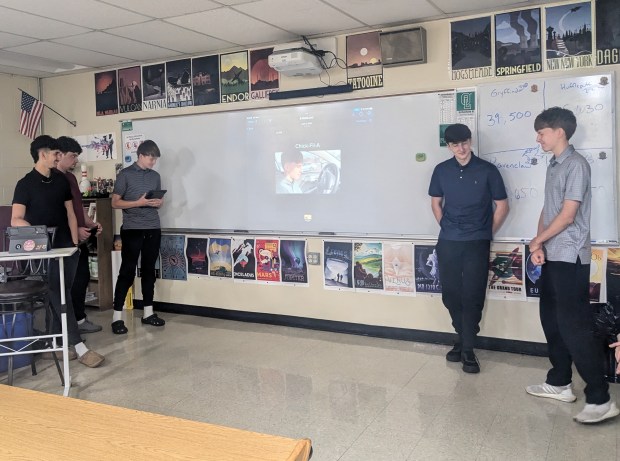Energy drinks became a thing for Maha Jaghama and her friends during the COVID-19 pandemic, when they dove in looking for a buzz to distract them from dreary days and isolation.
A couple of years afterward, they decided to find out how those kinds of beverages were affecting them and their peers through an interactive project at Oak Lawn Community High School. And in the process, Jaghama and her classmate Bridget Berkery discovered the caffeine and sugar-packed drinks are almost like a drug that can do more harm than good.
They were among the English Honors 2 students who read Eric Schlosser’s “Fast Food Nation” to learn about how what we eat impacts our health and culture, and then took their project outside the classroom to students and teachers at the school, as well as businesses in the Oak Lawn area.
They did interviews, taste tests with peers, surveys and research before presenting it to their peers as the school year drew to a close. Among their discoveries was that up to 70% of energy drinkers are teens, according to studies, and the beverages are marketed to teens based on packaging, design, taste, color and other elements.
They also learned the American Academy of Pediatrics advises children and teens avoid energy drinks because of their high caffeine content.
“The recommended caffeine is 100 mg daily,” Jaghama said. “A single can has 160 mg.”
During their research, the two asked students which energy drinks they liked best — Celcius, Red Bull and Monster were favorites.
The two interviewed nearby gas stations and store owners to see how many teens bought the drinks there. The results: many. They also looked at the ingredients in the drinks for unhealthy additives.
“We learned about how much society tries to hide what’s in them,” Berkery said. “We want to share that with other teens … we want to change their perception. They don’t know what is going into their bodies.”
Beyond warning them away from potentially harmful beverages, the project had a side benefit of getting the students outside of the school, brushing up on their interview skills and developing a sense of the world outside of the classroom.
“Doing the project helped us be social with the public,” Berkery said.
Jeff Vazzana, their English teacher, said the assignment was a capstone project that could help prepare them for next year’s AP Language course.
“It was a cool way for kids to show their mastery of what they’re learning and apply it to the real world,” he said.
The project, titled “How can Oak Lawn build a healthier, more sustainable food culture?” sparked student interest, the teacher said.
“I had them think about issues they cared about,” Vazzana said. “They all have a buy-in — everyone eats. And it’s timeless, there are always issues with food.”
Fellow students Laith Abbasi, Gabriel Fudala and Dylan Jones were part of a group that looked into the dangers of processed foods.
“We’re all athletes, so looked at what we’re putting into our bodies,” Abbasi said.
They scoured ingredients and decided if they couldn’t pronounce the first few, the food was most likely processed. Health teacher Scottie Miller told them high fructose corn syrup and artificial coloring also are red flags.
“I think it was more highlighting just how bad processed foods are for your body and why people use them so much,” Abbasi said. “It’s appealing, convenient and saves time … most of the processed foods are efficient in how you eat them.”
They also said processed food seemed more prevalent than in the past, causing more health concerns.
“In the past couple of years, the rates of diabetes and cardiovascular disease are really soaring,” said Gabriel Fudala, linking the high salt and sugar content to health problems.
The group did taste tests of fries at various fast-food restaurants to see what made the popular side dish more appealing.
“It can have an emotional connection to people,” Zain Mousa said about the draw of unhealthy fast food. “There’s aggressive marketing, catchy slogans and it’s targeted to (certain) populations.”
The students said during their presentation reading labels and cooking at home with fresh ingredients would help.
Many of the students showed a concern for how the food was affecting other people including younger generations.
“I’m concerned about how this would affect people across the globe in the long-term,” Abbasi said.
Janice Neumann is a freelance reporter for the Daily Southtown.





